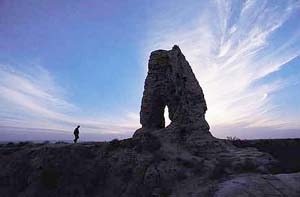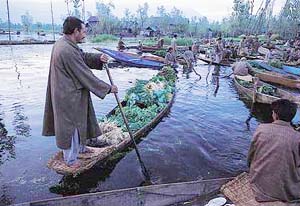|
A Tang Dynasty monk’s
historical journey from China to India during the 7th century is
recaptured in a photo exhibition which traces the epic journey through
unchartered frontiers.
By Catherine Siow
The Star, Malaysia - Traversing
turbulent rivers and vast deserts, scaling lofty mountains and passing
through desolate lands with no traces of human habitation, 7th century
Chinese monk Hsuan Tsang made his journey in 627 AD from Changan,
the capital of the Tang Dynasty (618-906 AD), to India for religious
purposes. His detailed travel journal is believed to be among the
earliest reliable sources of information about distant countries
whose terrain and customs had been known, at that time, in only
the sketchiest way.
Hsuan Tsang (602-664 AD) travelled
over land mostly on foot and horseback along the Silk Road, west
towards India. The Buddhist scholar’s pilgrimage (627-645 AD) contributed
enormously to the cultural flow between East and West Asia. Among
the various travelogues, Hsuan Tsang’s Hsi Yu Ki or Records of the
Western World (popularly known as Journey to the West) is considered
the most valuable book source for the study of ancient Indian history
and culture during the 7th century.
In later centuries, Hsuan Tsang was
immortalised as a saint and his journey popularised in fables and
vernacular literature. However, for the historian and explorer,
he contributed a precise and colourful account of the many countries
along the Silk Road.
Italian explorer Marco Polo, whose
travel writings fired the imagination of Europeans for centuries,
was believed to have used Hsuan Tsang’s travelogue as a guide during
his travels in the 13th century.
 |
| Sunset at
Suoyang City which is located to the west of the Hexi Corridor.
It is an ancient city on the vital passage of the Silk Road. |
Cultural heritage
More than 1,300 years after Hsuan
Tsang’s historical journey, Taiwanese magazine Rhythms Monthly embarked
on a project to retrace Hsuan Tsang’s 19-year pilgrimage. Rhythms
Monthly is a unit of Tzu Chi Cultural Publications, the publishing
arm of Tzu Chi Foundation, an international Buddhist organisation
based in Taiwan.
“In 1998, Tzu Chi volunteers went
to Afgha-nistan to distribute relief to refugees as part of the
Tzu Chi International Disaster Relief Programme,” said Wong Mun
Heng, a member of the Buddhist Tzu Chi Merit Society Kuala Lumpur.
“The chief editor of Rhythm Monthly,
Wang Chih-hung, was very impressed with the view of two giant Buddha
statues at the Bamiyan canyon. He then recalled that in the book
Journey to the West, Hsuan Tsang mentioned this scenery. That gave
him the idea of retracing the route undertaken by Hsuan Tsang.”
The Rhythms team, comprising journalists
and photographers from Taiwan, Hong Kong and Italy, started work
in 1998 and took five years and 10 expeditions to 11 countries across
Asia to complete a book, Retracing the Journey to the West in Tang
Dynasty, to preserve and promote Hsuan Tsang’s significant contributions.
The book (in Chinese) contains over 2,000 photographs of places
Hsuan Tsang has journeyed to. Some 200 photos from the book will
be showcased at an exhibition organised by the Buddhist Tzu Chi
Merit Society Kuala Lumpur at Berjaya Times Square in Kuala Lumpur
from July 9 to 18.
“Thanks to Hsuan Tsang who documented
his journey to the West, modern-day archaeologists and academicians
have his work to refer to,” said Wong. “By retracing the route,
we can learn how civilisations have changed over the years. More
importantly, it was to put on record a fair impression of Hsuan
Tsang.
“Unlike how he was portrayed in the
fictional version of Journey to the West, Hsuan Tsang was very much
a man of courage and wisdom as he dared to venture into unchartered
frontiers, overcoming numerous obstacles and challenges,” said Wong.
 |
| Morning market
at Dai Lake, Kashmir, where only men can be seen selling vegetables. |
“He was also a linguistic expert and
excellent diplomat as he crossed over 130 kingdoms of diverse cultures,
customs and languages. The people whom he met included the common
man in the street, learned monks and kings.”
Rare finds
In retracing Hsuan Tsang’s journey,
the Rhythms team visited 11 countries which included historical
landmarks in Western China, five Central Asia nations (Kazakhstan,
Kyrgyzstan, Uzbekistan, Tajikistan and Turkmenistan), Afghanistan,
Pakistan, Nepal, India and Bangladesh.
The photo exhibition covers six main
themes starting with Hsuan Tsang’s determination to make the journey
in 627 AD from Changan, crossing the Gobi Desert, traversing Central
Asia, sighting the giant Buddha statues in the Afghan Bamiyan Valley,
entering India through the Khyber Pass (northern Pakistan), and
visiting the scenic Kashmir Valley and holy places in India.
“Among the rare sights captured on
photo are the two giant Buddha statues in Bamiyan. The two standing
figures, said to be among the most valued treasures in the history
of Buddhism, were carved out of the precipitous sandstone cliffs
on the north side of the valley. The larger of the two stood at
53m and was believed to be 1,500 years old. It was the tallest Buddha
statue in the world until it was destroyed by the Taliban regime
in 2001,” said Wong.
“In Records of the Western World,
Hsuan Tsang gave a detailed description of the two statues which
were decorated with dazzling precious stones. Last year, Rhythms
took a picture of the sandstone cliffs, this time minus the two
Buddha statues. The Bamiyan Valley, known as the Valley of the Gods,
now lies in ruins. Refugees fleeing the ravages of war occupy caves
hewn out of the cliffs that once served as niches for Buddhist statues,”
Wong added.
The Retracing the Journey to the West
in Tang Dynasty photo exhibition (July 9-18) at Berjaya Times Square,
Kuala Lumpur, is open daily from 11am to 9pm. Admission is free.
The book, which comes with a 25-minute VCD, will be on sale during
the exhibition. For details, call 03-78809048 or visit www.tzuchi.org.tw.
|


